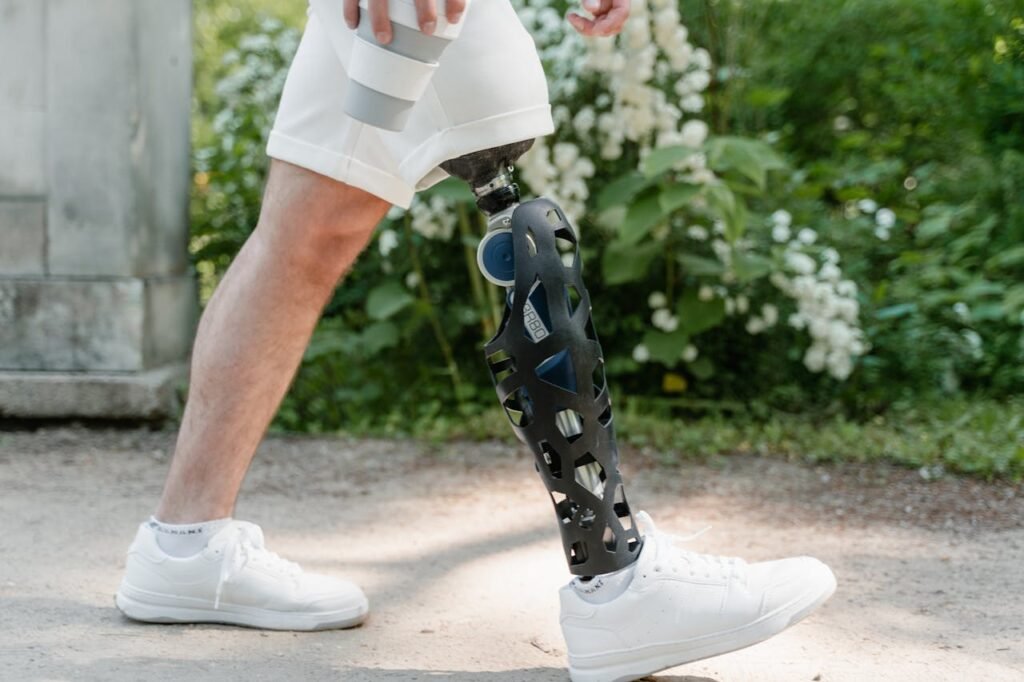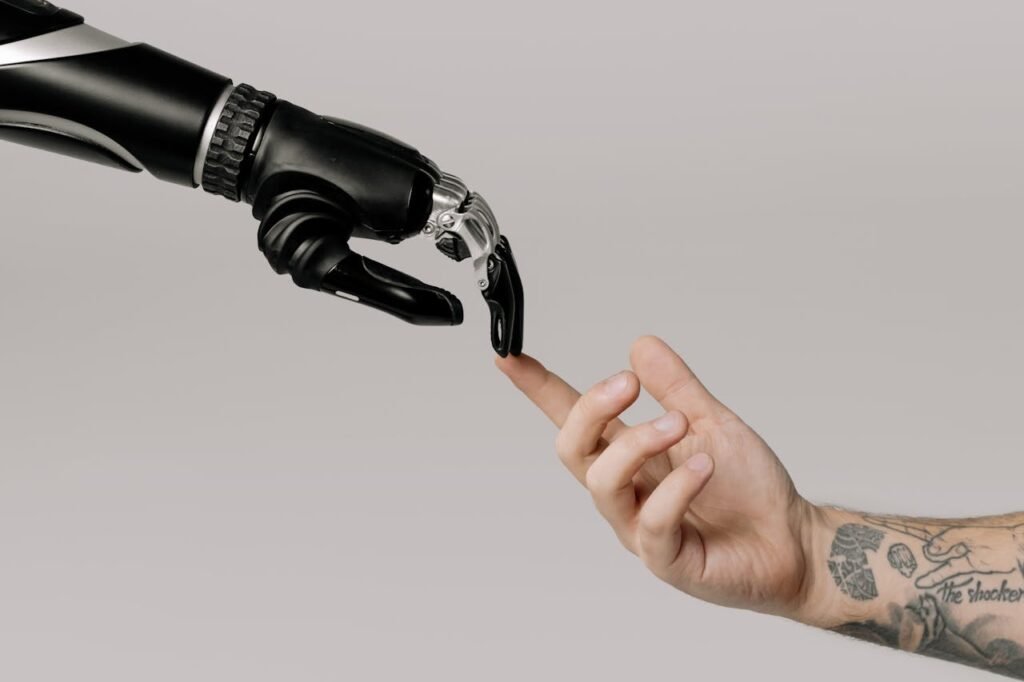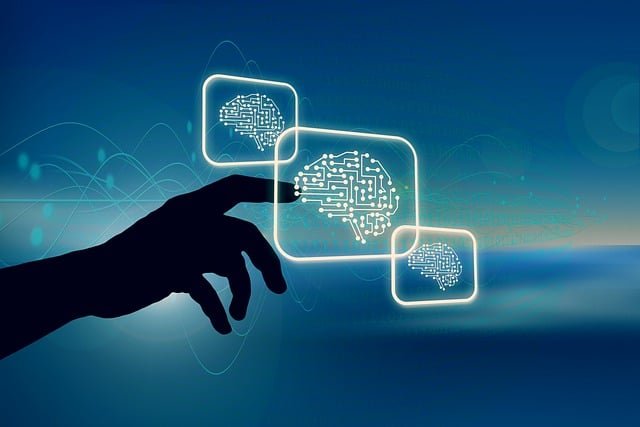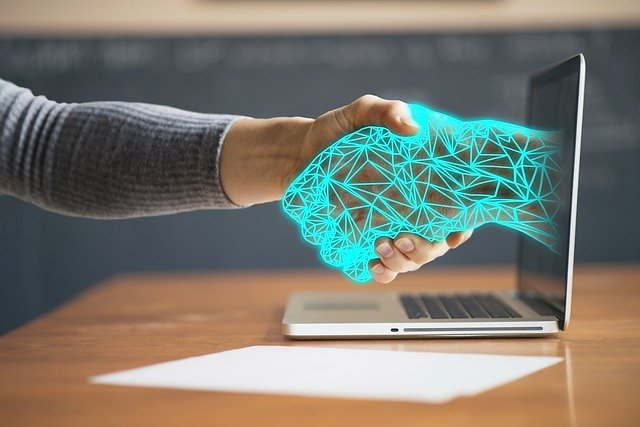Prosthetic technology has advanced significantly in the past decade, but one of the biggest breakthroughs is the use of machine learning (ML) to create customized prosthetic solutions. No two individuals are the same, and every prosthetic user has unique needs. Machine learning is making it possible to analyze movement patterns, muscle signals, and personal preferences to create prosthetics that feel like a natural part of the body.
At Robobionics, we believe that prosthetics should be intuitive, adaptive, and personalized. With machine learning, prosthetic limbs are becoming smarter and more responsive, ensuring greater comfort, better control, and improved functionality. In this article, we explore how machine learning is shaping the future of prosthetics, offering a more personalized experience for users worldwide.
1. How Machine Learning is Revolutionizing Prosthetic Design
Traditional prosthetics are designed using fixed models, but ML is changing the process entirely by creating data-driven, adaptive designs that fit each user perfectly.
Machine learning algorithms analyze biometric data, muscle signals, gait patterns, and limb structure to create personalized prosthetic models. These algorithms continuously learn and adjust, ensuring that each prosthetic is designed to match the user’s natural movements. Instead of relying on manual adjustments, AI-driven software can predict and correct alignment issues, reducing discomfort and enhancing performance.
By 2030, prosthetic users will have fully customized devices tailored to their lifestyle, mobility levels, and activity preferences. This means better comfort, fewer adjustments, and a more natural feel, ensuring greater independence and confidence in everyday life.
2. Machine Learning for Real-Time Movement Adaptation

One of the most exciting applications of ML in prosthetics is real-time movement adaptation. Traditional prosthetic limbs follow pre-programmed motions, but ML-powered limbs can learn and adjust instantly.
By analyzing electromyography (EMG) signals from muscles, machine learning algorithms can detect user intentions and fine-tune movements automatically. For example, if a person is walking on a slope, the prosthetic limb can adjust the ankle position for better stability. Similarly, AI-powered hands can detect grip strength and automatically adjust to hold delicate objects securely without breaking them.
By 2030, ML-enabled prosthetics will become fully responsive, allowing users to perform a wide range of activities—from walking on uneven terrain to grasping fragile objects—with natural ease. This will eliminate the need for constant manual adjustments, making prosthetic use more intuitive and effortless.
3. The Role of Machine Learning in Prosthetic Fit and Comfort
A poorly fitted prosthetic can cause pain, discomfort, and skin irritation. ML is helping prosthetists create better-fitting limbs by using 3D scanning and AI-driven adjustments.
By analyzing residual limb shape, pressure points, and daily movement habits, ML algorithms can generate precise socket designs that provide maximum comfort and stability. These systems also monitor how the prosthetic interacts with the skin and adjust pressure points to prevent soreness and irritation.
By 2030, machine learning will eliminate the trial-and-error process in prosthetic fitting, ensuring a perfect, pain-free fit for every user. This will enhance mobility, reduce discomfort, and allow users to wear their prosthetic limbs for longer periods without fatigue.
4. AI-Powered Predictive Maintenance for Prosthetics

Wear and tear are inevitable in prosthetics, but machine learning is making maintenance smarter and more efficient.
ML-powered prosthetics will track usage patterns, detect early signs of wear, and predict when repairs are needed. Sensors embedded in the prosthetic will collect real-time data on movement, pressure, and material strain, allowing the system to alert users before a malfunction occurs.
By 2030, predictive maintenance will become standard, reducing the need for unexpected repairs and costly replacements. Users will experience greater reliability, longer-lasting devices, and fewer disruptions in their daily lives.
5. Machine Learning in Prosthetic Training and Rehabilitation
Learning to use a prosthetic limb requires time, patience, and practice, but ML is making this process easier and more engaging.
AI-driven training programs use virtual simulations and real-time feedback to help users adjust to their new prosthetics. By tracking movement patterns, ML-powered rehab tools can recommend personalized exercises that improve muscle control and coordination. These programs can also detect errors in movement and offer instant corrections, ensuring faster learning and better long-term adaptation.
By 2030, prosthetic training will be fully AI-driven, providing real-time coaching and gamified rehabilitation, helping users become comfortable with their prosthetics faster and more efficiently.
6. Neural Interfaces and Machine Learning: The Future of Brain-Controlled Prosthetics
The next frontier in prosthetics is brain-controlled limbs, where users can move their prosthetics just by thinking about it. Machine learning is at the heart of this innovation, helping translate brain signals into precise movements.
ML algorithms analyze neural activity and map signals to specific muscle commands, allowing users to control their prosthetics with greater accuracy and speed. Over time, these systems will learn and adapt, making movements smoother and more natural.
By 2030, brain-machine interfaces (BMIs) combined with machine learning will allow for fully intuitive prosthetic control, bringing prosthetic limbs closer to natural human function than ever before.
7. The Future of Personalized Prosthetics with Machine Learning

As machine learning continues to advance, prosthetics will become more personalized, adaptive, and efficient. Future AI-driven prosthetics will be able to self-adjust based on user activity, providing a seamless, natural experience.
ML-powered prosthetics will integrate health monitoring, predictive maintenance, real-time movement adaptation, and brain-controlled interfaces, creating the most advanced artificial limbs in history. These innovations will give users more freedom, greater confidence, and improved mobility, making prosthetic use as natural as possible.
At Robobionics, we are committed to leading the future of AI-driven prosthetic technology, ensuring that users experience cutting-edge, intelligent solutions designed for comfort, functionality, and independence.
8. The Role of Machine Learning in Adaptive Grip Control for Bionic Hands
One of the most critical functions of an upper-limb prosthetic is grip control. Traditional prosthetic hands rely on preset grip patterns, which can be rigid and unnatural. With machine learning, bionic hands can now learn from user behavior and adjust grip strength, speed, and precision automatically.
Machine learning algorithms analyze how users hold different objects, allowing the prosthetic to adapt its grip for fragile, slippery, or heavy items. For example, if a user picks up a glass of water, the ML-powered prosthetic will automatically apply just enough pressure to hold it securely without crushing it.
By 2030, prosthetic hands will feature fully autonomous grip control, responding instantly to user intent, muscle signals, and object characteristics. This will allow seamless interaction with everyday objects, making artificial hands feel more like natural extensions of the body.
9. Machine Learning in Lower-Limb Prosthetics: Enhancing Walking and Running

For leg prosthetic users, walking on different surfaces can be challenging. Traditional prosthetic legs operate with fixed mechanics, requiring users to adjust their walking style manually. Machine learning is now making it possible for prosthetic legs to analyze gait patterns and adapt to various terrains in real time.
AI-powered prosthetic legs can detect whether the user is walking on grass, gravel, or stairs and adjust foot placement, ankle angle, and shock absorption accordingly. These intelligent systems help improve balance, reduce strain on the body, and enhance energy efficiency during movement.
By 2030, ML-driven lower-limb prosthetics will provide a natural walking experience, allowing users to move with greater stability, flexibility, and control, whether they are walking, running, or climbing stairs.
10. AI-Driven Pain Management: Reducing Phantom Limb Pain with Machine Learning
Many amputees experience phantom limb pain, where they feel sensations from the missing limb. This can be uncomfortable and disruptive to daily life. Machine learning is now being used to analyze nerve signals and create personalized pain relief strategies.
By studying neural activity and muscle responses, ML-powered prosthetics can send counter-signals that trick the brain into reducing pain sensations. AI can also integrate virtual reality therapy, allowing users to “see” and control their missing limb in a virtual environment, which has been proven to reduce phantom limb pain significantly.
By 2030, ML-powered pain management systems will become standard in advanced prosthetics, helping users experience greater comfort and fewer pain-related challenges.
11. Smart Prosthetics That Learn Over Time: AI-Powered Personalization
One of the most exciting developments in prosthetic technology is the ability for devices to learn and evolve based on user experience. Traditional prosthetics require constant manual adjustments, but machine learning allows prosthetics to become smarter with use.
AI-powered prosthetic limbs collect data on movement, pressure, and user preferences to continuously improve performance. If a user prefers a certain walking style or grip pattern, the prosthetic will adapt accordingly, making movements feel more natural over time.
By 2030, prosthetic users will have fully personalized AI-driven devices that get better the longer they are used, offering an unmatched level of adaptability and comfort.
12. Machine Learning in Gamified Rehabilitation: Making Training More Engaging

Rehabilitation after amputation can be challenging and repetitive, but machine learning is making it more engaging and effective through gamified training programs.
AI-powered rehab tools use motion tracking and real-time feedback to help users practice movements in a virtual environment. Games that involve grabbing virtual objects, walking through obstacle courses, or completing balance challenges keep users motivated while improving their prosthetic control.
By 2030, gamified AI rehab programs will be fully personalized, adjusting difficulty levels based on user progress, ensuring faster and more enjoyable recovery experiences.
13. AI-Powered Voice Control for Hands-Free Prosthetic Operation
For individuals with limited upper-body mobility, operating a prosthetic limb can be difficult. Machine learning is now enabling voice-controlled prosthetics, allowing users to command their artificial limbs using speech.
AI-driven speech recognition systems will analyze user commands and context, allowing for smooth, responsive movements. For example, a user can say, “Grip the bottle lightly”, and the prosthetic hand will adjust its grip strength accordingly.
By 2030, voice-assisted prosthetics will be widely available, providing greater independence for users with limited muscle control or multiple limb amputations.
14. AI-Enhanced Prosthetic Integration with Smart Homes and IoT
Machine learning is enabling prosthetic devices to communicate with smart home systems, creating a fully integrated, accessible environment.
AI-powered prosthetics will sync with smart home assistants, automatic doors, and connected appliances, allowing users to control lights, adjust room temperatures, and operate household devices with a simple motion or voice command.
By 2030, prosthetic users will experience a seamless connection between their limbs and their environment, making everyday tasks more convenient and accessible.
15. Ethical Considerations and the Future of AI in Prosthetic Development

As machine learning continues to advance, there are ethical and practical questions about data privacy, accessibility, and affordability.
Ensuring that AI-powered prosthetics are accessible to all—not just those who can afford high-end models—will be critical. At Robobionics, we believe in making advanced prosthetic technology affordable and widely available, ensuring that every user benefits from ML-driven customization.
By 2030, AI in prosthetics will be regulated to ensure ethical usage, balancing innovation with affordability and accessibility, so that all individuals with limb loss can benefit from cutting-edge solutions.
16. Machine Learning in 3D-Printed Prosthetics: Faster, Smarter, and More Affordable
3D printing has already revolutionized prosthetic manufacturing, but machine learning is making it even more precise, efficient, and cost-effective.
AI-driven design software can analyze limb structure, movement patterns, and pressure distribution to create highly personalized 3D-printed prosthetics that fit perfectly and function optimally. Unlike traditional methods, which require multiple fittings and manual adjustments, ML-based 3D printing reduces errors and speeds up the process, making custom prosthetics more affordable and accessible.
By 2030, ML-powered 3D printing will allow prosthetics to be produced on-demand, ensuring that anyone, anywhere, can receive a custom-fit prosthetic at a fraction of the current cost.
17. AI-Driven Sensory Feedback: Restoring the Sense of Touch in Prosthetic Limbs
One of the biggest challenges in prosthetic technology has been restoring the sense of touch. Traditional prosthetics lack sensory feedback, making it hard for users to judge pressure, temperature, or texture.
Machine learning is solving this by analyzing nerve signals and translating them into haptic feedback. AI-powered prosthetic limbs will use electronic skin and smart sensors to detect touch, vibration, and temperature, then send signals to the brain, simulating real sensations.
By 2030, ML-driven haptic feedback will become a standard feature in high-tech prosthetics, giving users a more natural, responsive experience when interacting with objects.
18. AI in Multi-Terrain Prosthetics: Smarter Walking for Any Environment

Walking on sand, ice, mud, or steep inclines can be difficult for prosthetic users, but ML is making multi-terrain adaptability a reality.
Machine learning algorithms can detect terrain changes in real-time, adjusting foot angle, ankle movement, and step force to ensure better stability and efficiency. AI-powered prosthetic legs will be able to predict movement needs, automatically optimizing shock absorption and balance to prevent falls.
By 2030, ML-powered prosthetic legs will allow users to move across any surface with confidence, making outdoor adventures, hiking, and running on uneven terrain more accessible than ever before.
19. Machine Learning for Better Energy Efficiency in Prosthetic Limbs
One of the biggest limitations of high-tech prosthetics is battery life. Advanced prosthetics require constant power for sensors, AI processing, and movement control, leading to frequent recharging.
Machine learning is helping solve this by optimizing energy use based on movement patterns and user activity. AI-powered prosthetics will automatically switch to low-power modes when the user is resting and redistribute energy efficiently during active movement.
By 2030, prosthetic limbs will feature self-learning power management, ensuring longer battery life, faster charging, and better overall efficiency, reducing the need for frequent charging or battery replacements.
20. The Future of Fully Autonomous AI Prosthetics: A Vision for 2030 and Beyond
The ultimate goal of AI in prosthetics is to create fully autonomous, self-learning artificial limbs that feel and function just like natural limbs.
By integrating real-time AI movement adaptation, haptic sensory feedback, neural control, and predictive adjustments, prosthetics will no longer require manual settings or recalibration—they will think and respond automatically.
By 2030, AI-driven prosthetics will be so advanced that they will feel like a seamless extension of the user’s body, providing effortless control, comfort, and adaptability.
Final Thoughts: Machine Learning is Creating a New Era of Prosthetics
Machine learning is transforming prosthetic technology, making artificial limbs smarter, more adaptive, and highly personalized. From real-time movement adaptation and predictive maintenance to brain-controlled interfaces and AI-driven rehabilitation, ML is revolutionizing how prosthetics are designed, fitted, and used.
At Robobionics, we are at the forefront of these innovations, ensuring that our prosthetic solutions are designed with the latest machine learning advancements for greater comfort, precision, and ease of use.
If you’re ready to experience the next generation of AI-powered prosthetics, book a free demo with Robobionics today and take the first step toward a future where prosthetic limbs feel as natural as your own!



